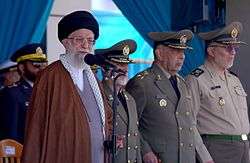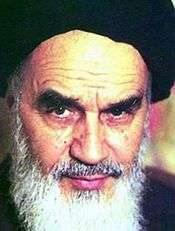Supreme Leader of Iran
| Supreme Leader of the Islamic Republic of Iran | |
|---|---|
|
Official standard | |
| Residence | Beit Rahbari, Tehran |
| Seat | Tehran, Iran |
| Appointer | Assembly of Experts |
| Term length | Life tenure[1] |
| Inaugural holder | Ruhollah Khomeini |
| Formation | 3 December 1979 |
| Website | Office of the Supreme Leader |
| This article is part of a series on the |
| Politics of the Islamic Republic of Iran |
|---|
 |
| Government of Islamic Republic of Iran |
|
Supreme Councils |
|
Local governments |
|
|
|
The Supreme Leader of Iran (Persian: رهبر ایران, rahbar-e iran), also called the Supreme Leader of the Islamic Revolution[2] (رهبر معظم انقلاب اسلامی, rahbar-e mo'azzam-e enghelab-e eslami), officially in Iran, called the Supreme Leadership Authority (Persian: مقام معظم رهبری), is the head of state and highest ranking political and religious authority in the Islamic Republic of Iran.
This post was established by the Constitution of the Islamic Republic of Iran in accordance with the concept of the Guardianship of the Islamic Jurist.[3] According to the Constitution, the powers of government in the Islamic Republic of Iran are vested in the legislature, the judiciary, and the executive powers, functioning under the supervision of the Absolute Guardianship and the Leadership of the Ummah (Persian: ولایت مطلقه امر و امامت امت) that refers to the Supreme Leader.[4] The title "Supreme" Leader (Persian: رهبر معظم, rahbar-e mo'azzam) is often used as a sign of respect; however, this terminology is not found in the Constitution, which simply referred to the "Leader" (rahbar; رهبر).
The Supreme Leader is more powerful than the President of Iran and appoints the heads of many powerful posts in the military, the civil government, and the judiciary.[5] Originally Iran's constitution stated that the Supreme Leader must be a Marja'-e taqlid, the highest ranking cleric and authority on religious laws in Usuli Twelver Shia Islam. However, in 1989, the constitution was amended to require simply Islamic "scholarship" of the leader, i.e., the leader could be a lower ranking cleric.[6][7]
In its history, the Islamic Republic has had two Supreme Leaders: Ruhollah Khomeini, who held the position from 1979 until his death in 1989, and Ali Khamenei, who has held the position since Khomeini's death.
In theory, the Supreme Leader is appointed and supervised by the Assembly of Experts. All candidates to the Assembly of Experts, the President and the Majlis (Parliament), are selected by the Guardian Council, whose members are selected by the Supreme Leader of Iran.[8] As such, the Assembly has never questioned the Supreme Leader.[9] There have been instances when the current Supreme Leader Ali Khamenei has publicly criticized members of the Assembly of Experts, resulting in their arrest and dismissal. For example, Khamenei publicly called then-member of the Assembly of Experts Ahmad Azari Qomi a traitor, resulting in Ahmad Azari Qomi's arrest and eventual dismissal from the Assembly of Experts. There has also been instances where the Guardian Council reversed its ban for particular people after being ordered to do so by Khamenei.[10] The Supreme Leader issues decrees and makes the final decisions on economy, environment and everything else.[11][12][13] Any declaration of war or peace is supposed to be made by the Supreme Leader together with a two-thirds majority of Parliament.
Mandate and Status
The Supreme Leader of Iran is elected by the Assembly of Experts (Persian: مجلس خبرگان, Majles-e Khobregan), which is also in charge of overseeing the Supreme Leader and confirming him in his position for a term of eight years, without prohibition to the number of terms.
The Supreme Leader is the commander-in-chief of the armed forces and the provisional Head of the three branches of the state (the Judiciary, the Legislature, and the Executive).
He appoints (or inaugurates) and oversees the following offices:
- (inaugurates) the President and may also together with a two third majority of the Parliament impeach him.
- the Chief Justice (head of the Judiciary Branch (Persian: قوه قضائیه) usually a member of the Council of Experts) for a term of 8 years,
- the members of the Expediency Discernment Council for a term of 5 years.
- 6 of the 12 Members of the Guardian Council from among the members of the Council of Experts the other 6 are chosen by the Parliament.
- the head of the National Radio and Television Institution IRIB for a term of 8 years
- the head of the Foundation of Martyrs and Veterans Affairs
- the Imams of the Friday Prayer of each Province Capital (with the advice of all the Marja') for a lifetime
- Armed Forces of the Islamic Republic of Iran
- the Commander of the Armed Forces of the Islamic Republic of Iran
- the Commander of the Islamic Republic of Iran Army
- the Commander of the Islamic Republic of Iran Navy
- the Commander of the Islamic Republic of Iran Air Force
- the Commander of the Islamic Republic of Iran Air Defense Force
- Islamic Revolutionary Guard Corps (IRGC)
- the Commander of the IRGC
- the Commander of the IRGC Ground Forces
- the Commander of the IRGC Navy
- the Commander of the IRGC Aerospace Force
- the Commander of the IRGC Quds Force
- the Commander of the Basij Organization
- the Commander of the Law Enforcement Force
- the Heads of the Counter Intelligence Units
- the Heads of the Intelligence Units
Also the declaration of war and peace is to be made by the Supreme Leader together with a two third majority of the Parliament.[14]
Incorporation in the Constitution
1979
In March 1979, shortly after Ruhollah Khomeini’s return from exile and the overthrow of Iran's monarchy, a national referendum was held throughout Iran with the question "Islamic Republic, yes or no?".[15] Although some groups objected to the wording and choice and boycotted the referendum, 98% of those voting voted "yes".[15] Following this landslide victory, the constitution of Iran of 1906 was declared invalid and a new constitution for an Islamic state was created and ratified by referendum during the first week of December in 1979. The new constitution has been called a "hybrid" of "theocratic and democratic elements"[16] with much of it based on the ideas Khomeini presented in his work Islamic Government: Governance of the Jurist (Hukumat-e Islami). In it Khomeini argued that government must be run in accordance with traditional Islamic sharia, and for this to happen a leading Islamic jurist (faqih) must provide political "guardianship" (wilayat or velayat) over the people. The leading jurist were known as Marja'.
The Constitution stresses the importance of the clergy in government, with Article 4 stating that
“all civil, criminal, financial, economic, administrative, cultural, military, political, and all other statutes and regulations (must) be keeping with Islamic measures;…the Islamic legal scholars of the watch council (shura yi nigahban) will keep watch over this.”[17]
and the importance of the Supreme Leader. Article 5 states
“during the absence of the removed Twelfth Imam (may God hasten his reappearance) government and leadership of the community in the Islamic Republic of Iran belong to the rightful God fearing… legal scholar (Faqih) who is recognized and acknowledged as the Islamic leader by the majority of the population.”
Article 107 in the constitution mentions Imam Khomeini by name and praises him as the most learned and talented leader for emulation (marja-i taqlid). The responsibilities of the Supreme Leader are vaguely stated in the constitution, thus any ‘violation’ by the Supreme Leader would be dismissed almost immediately. As the rest of the clergy governed affairs on a daily basis, the Supreme Leader is capable of mandating a new decision as per the concept of Vilayat-e Faqih. (Halm, 120-121)
1989
Shortly before Imam Khomeini's death a change was made in the constitution allowing a lower ranking Shia cleric to become Supreme Leader. Khomeini had a falling out with his successor Hussein-Ali Montazeri who disapproved of human rights abuses by the Islamic Republic[18] such as the mass execution of political prisoners in late summer and early autumn 1988. Montazeri was demoted as a marja and Khomeini chose a new successor, a relatively low-ranking member of the clergy, Ali Khamene'i. However Article 109 stipulated that the leader be `a source of imitation` (Marja-e taqlid). Khomeini wrote a letter to the president of the Assembly for Revising the Constitution, which was in session at the time, making the necessary arrangements to designate Khamene'i as his successor, and Article 109 was revised accordingly.[19] "Khomeini is supposed to have written a letter to the Chairman of the assembly of Leadership Experts on 29.4.89 in which he emphasised that he had always been of the opinion that the marja'iyat was not a requirement for the office of leader.[19]
Guardianship of the Islamic Jurist (Velayat-e faghih)
The constitution of Iran combines concepts of both democracy and theocracy, theocracy in the form of Khomeini's concept of vilayat-e faqih (Guardianship of the Islamic Jurist), as expressed in the Islamic Republic. According to Ayatollah Khomeini, the Guardianship of the Islamic Jurist was not restricted to orphans or mental incompetents, but applied to everyone in absence of the twelfth Imam. Jurists were the only rightful political/governmental leaders because "God had commanded Islamic government" and "no one knew religion better than the ulama" (Islamic clergy).[20] They alone would preserve "Islamic order" and keep everyone from deviating from "the just path of Islam".[21] Prior to the revolution observant Shia Muslims selected their own leading faqih to emulate (known as a Marja'-i taqlid) according to their own decision making. The “congregation rather than the hierarchy decided how prominent the ayatollah was” thus allowing the public to possibly limit the influence of the Faqih.[20]
After the revolution Shia Muslims (or at least Iranian Shia) were commanded to show allegiance to the current vali-e faghih, Guardian Jurist or Supreme Leader. In this new system, the jurist oversaw all governmental affairs. The complete control exercised by the Faqih was not to be limited to the Iranian Revolution because the revolution and its Leader had international aspirations. As the constitution of the Islamic Republic states, it
intends to establish an ideal and model society on the basis of Islamic norms. ... the Constitution provides the necessary basis for ensuring the continuation of the Revolution at home and abroad. In particular, in the development of international relations, the Constitution will strive with other Islamic and popular movements to prepare the way for the formation of a single world community (in accordance with the Koranic verse `This your community is a single community, and I am your Lord, so worship Me` [21:92]), and to assure the continuation of the struggle for the liberation of all deprived and oppressed peoples in the world.[22]
According to author Seyyed Vali Nasr, Khomeini appealed to the masses, during the pre-1979 period, by referring to them as the oppressed and with charisma and political ability was tremendously successful. He became a very popular role model for Shiites and hoped for the Iranian Revolution to be the first step to a much larger Islamic revolution, transcending Shia Islam, in the same way that Vladimir Lenin and Leon Trotsky wanted their revolution to be a world revolution, not just a Russian one.[23]
Functions and duties of the Supreme Leader

According to Article 110 of the Constitution,[17] the Duties and Powers of the Supreme Leader are:
- Delineation of the general policies of the Islamic Republic of Iran after consultation with the Nation's Expediency Discernment Council.
- Supervision over the proper execution of the general policies of the systems.
- Issuing decrees for national referendums.
- Assuming supreme command of the armed forces.
- Declaration of war and peace, and the mobilization of the armed forces.
- Appointment, dismissal, and acceptance of resignation of:
- the fuqaha' on the Guardian Council.
- the supreme judicial authority of the country.
- the head of the radio and television network of the Islamic Republic of Iran.
- the chief of the joint staff.
- the chief commander of the armed forces of the country
- the supreme commanders of the armed forces.
- Resolving differences between the three wings of the armed forces and regulation of their relations.
- Resolving the problems, which cannot be solved by conventional methods, through the Nation's Expediency Discernment Council.
- Signing the decree formalizing the elections in Iran for the President of the Republic by the people.
- Dismissal of the President of the Republic, with due regard for the interests of the country, after the Supreme Court holds him guilty of the violation of his constitutional duties, or after an impeachment vote of the Islamic Consultative Assembly (Parliament) testifying to his incompetence on the basis of Article 89 of the Constitution.
- Pardoning or reducing the sentences of convicts, within the framework of Islamic criteria, on a recommendation (to that effect) from the head of the Judiciary. The Supreme Leader may delegate part of his duties and powers to another person.
List of Supreme Leaders

| Numerical order | Supreme Rule | Portrait | Name English · Persian · Signature |
Lifespan | Place of birth | Political Party | Notes | |
|---|---|---|---|---|---|---|---|---|
| 1 | 3 December 1979 – 3 June 1989 (9 years, 182 days) |
 |
Grand Ayatollah Sayyid Ruhollah Khomeini سیدروحالله خمینی  |
22 September 1902 – 3 June 1989 (aged 86) | Khomeyn, Markazi Province | Independent | Leader of the 1979 Iranian Revolution, and founder of the Islamic Republic of Iran. | |
| 2 | 4 June 1989 – present (27 years, 187 days) |
 |
Grand Ayatollah Sayyid Ali Khamenei سیدعلی خامنهای |
17 July 1939 | Mashhad, Razavi Khorasan Province | Combatant Clergy Association | Previously served as President of Iran from 1981 to 1989 until Khomeini's death. | |
See also
- Politics of Iran
- Constitution of the Islamic Republic of Iran
- Iranian Supreme Leader election, 1989
- Next Iranian Supreme Leader election
References
- ↑ "Iran's possible next Supreme Leader being examined: Rafsanjani". 13 December 2015. Retrieved 1 July 2016 – via Reuters.
- ↑ Article 89-91, Iranian Constitution
- ↑ Article 5, Iranian Constitution
- ↑ Constitution of Iran Unofficial English translation hosted at University of Bern, Switzerland (with good summaries)
- ↑ "Who's in Charge?" by Ervand Abrahamian London Review of Books, 6 November 2008
- ↑ Moin, Baqer, Khomeini, (2001), p.293
- ↑ "Article 109 [Leadership Qualifications]
(1) Following are the essential qualifications and conditions for the Leader:
a. Scholarship, as required for performing the functions of religious leader in different fields. - ↑ Reuters (14 December 2015). "Rafsanjani breaks taboo over selection of Iran's next supreme leader". Retrieved 1 July 2016.
- ↑ "Everything you need to know about Iran's Assembly of Experts election". Retrieved 1 July 2016.
- ↑ Staff and agencies (24 May 2005). "Iran reverses ban on reformist candidates". Retrieved 1 July 2016.
- ↑ "Khamenei says Iran must go green". 18 November 2015. Retrieved 1 July 2016.
- ↑ "Exclusive: Iran pursues ballistic missile work, complicating nuclear talks". 16 May 2014. Retrieved 1 July 2016 – via Reuters.
- ↑ "Asking for a Miracle: Khamenei's Economic Plan". Retrieved 1 July 2016.
- ↑ Article 110, Iranian Constitution
- 1 2 Duality by Design: The Iranian Electoral System By Yasmin Alem
- ↑ While articles One and Two vest sovereignty in God, article six "mandates popular elections for the presidency and the Majlis, or parliament." source: JULY 27, 2009, Iran, Islam and the Rule of Law. FRANCIS FUKUYAMA
- 1 2 "ICL - Iran - Constitution". Retrieved 1 July 2016.
- ↑ Keddie, Nikki R.; Yann Richard (2003). Modern Iran: Roots and Results of Revolution. New Haven, Connecticut: Yale University Press. p. 260.
- 1 2 Schirazi, Asghar, The Constitution of Iran : politics and the state in the Islamic Republic / by Asghar Schirazi, London ; New York : I.B. Tauris, 1997 p.73-75
- 1 2 Nasr, Seyyed Vali Reza, The Shia Revival: How Conflicts within Islam Will Shape the Future, W. W. Norton & Company, Apr 17, 2007, p.?
- ↑ Khomeini, Islam and Revolution, Writings and Declarations Of Imam Khomeini p.54
- ↑ "ICL - Iran - Constitution". Retrieved 1 July 2016.
- ↑ Nasr, Seyyed Vali Reza, The Shia Revival: How Conflicts within Islam Will Shape the Future, W. W. Norton & Company, Apr 17, 2007, p.137
External links
| Wikimedia Commons has media related to Supreme Leaders of Iran. |
- Official website of the Office of the Supreme Leader
- Iranian constitution
- WorldStatesmen- Iran
- Iran Electoral Archive - Supreme Leader


.jpg)